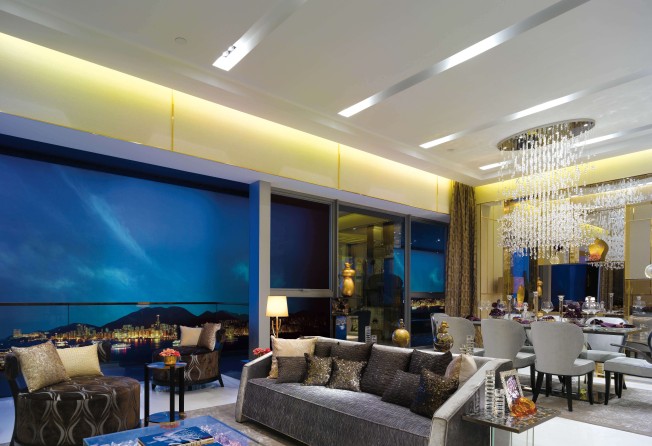Wong Tai Sin’s gentrification draws wealthy to crossroads of Kowloon
The district thrives on its transport links, proximity to schools and modern residential developments

The most photogenic local landmark in Wong Tai Sin might be its famous temple, but another development comes in a close second.
Choi Hung Estate is one of the oldest public housing areas in Hong Kong, and also one of the densest. Completed between 1962 and 1964, the estate consisted of 11 residential blocks, five schools and various shops and restaurants. It was designed as a mini-city to house 40,000 people – although government records show 18,600 residents as at June 30 this year.
Built to house low-income people in a populous area of Kowloon, the estate shot to international fame following artist-photographer Michael Wolf’s portrayal of crowded Hong Kong. It has since become the subject of numerous photo opportunities – from tourist selfies, to high-end fashion shoots.
Location-wise, the estate’s planners – an in-house government architecture team – were spot on. The property in Ngau Chi Wan, Wong Tai Sin District of eastern Kowloon, is surrounded by several major roads: Lung Chung Road to the north; Prince Edward Road East to the south; the Kwun Tong bypass heading west; and Clear Water Bay Road to the east.
According to the Home Affairs Department, Wong Tai Sin district remains “a community of grassroots”. Census data shows that about 80 per cent of the population live in subsidised housing developments, and about 17 per cent are elderly citizens, the highest in the territory. “Yet, the community is full of vitality and care,” writes Wong Tai Sin district officer Annie Kong.
Private developers added upper-class residential projects. Sun Hung Kai Properties built two: The
Latitude at 638 Prince Edward Road East, in San Po Kong; and Aria, at 51 Fung Shing Street in Ngau Chi Wan. The Latitude comprises 1,159 units in five towers – typically one to four bedrooms ranging from 446 sq ft to 1,596 sq ft – a three-storey clubhouse and shopping mall. Aria, providing 723 units in five towers (also one to four bedrooms, from 419 sq ft to 1,672 sq ft), has a heated indoor pool and spa plus a clubhouse, Club Aria, with banquet room and wine bar. Both properties were completed some years ago and are now selling as resales only.
More recently, Kerry Properties built Lions Rise, a five-block, 968-unit development with club facilities, landscaped gardens and shopping mall. Completed in 2012, the development was well-received. According to Kent Ho Wai-fung, branch manager of Centaline Central Kowloon Galaxia branch, these private developments’ facilities lead residents already living in the district to upgrade their homes.
They need to pay considerably more. At Lung Poon Court, an older government-housing building very near to the MTR, monthly rental for a two-bedroom unit is about HK$14,000, or HK$13,000 for one-bedroom, compared with about HK$20,000 for a newer unit at Lions Rise. Supply is low, and demand is heavy: when units do come on the rental market, they are usually snapped up within two weeks.
Families are attracted to the district for several reasons. One is its proximity to a desirable school network. “Many people live in Wong Tai Sin, where the price is lower, and [their children] go to school in Kowloon Tong or Ho Man Tin, which is only six or seven minutes away by MTR,” Ho says.
Travel is easy, as Wong Tai Sin and Diamond Hill MTR stations are within walking distance, and the upcoming Sha Tin to Central Line will provide more connections.
Wong Tai Sin district is also very close to the Kai Tak development, the new “green heart” of Kowloon East generating parkland-themed leisure and sporting activities, as well as business and employment opportunities.
Henry Mok, regional director at JLL, agrees that recent projects such as Lions Rise have injected fresh energy into an area which has good credentials.
“Wong Tai Sin is a mature area in Kowloon with very good transportation facilities,” he says. “Any new future developments within the vicinity will definitely attract buyers from other districts in Kowloon area.”
However, there may be little in the pipeline. JLL’s in-house database shows only two upcoming residential projects, and just one of these is confirmed.
Aspen Court, by Far East Consortium, will provide 234 units with completion expected in 2018. The 29-storey residential tower on Wan Fung Street, Wong Tai Sin is comprised of studio, one-bedroom, two-bedroom and special units, with management by Jones Lang LaSalle Management Services.
“Pricing achieved in the primary sales market has been HK$14,000 to HK$20,000 per square foot saleable area,” Mok says.
The Nga Tsin Wai Village, an Urban Renewal Authority project, is slated to provide 750 units on the site of a revitalised walled urban village.
Although the existing structures were considered too decrepit for restoration, the intention is to preserve three historical relics of value, namely the village gatehouse, the embedded stone tablet and the Tin Hau Temple.
“Per the project’s web site, its expected completion is 2019, but so far, only demolition consent has been obtained,” Mok says.